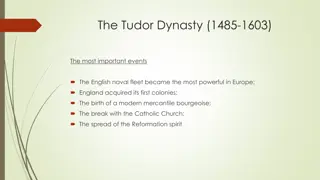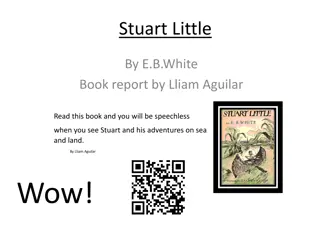The English Civil War and the Rise of the Stuart Dynasty
The English Civil War marked the end of the Tudor dynasty and the rise of the Stuart Dynasty in England. It was a time of conflict between the monarchy and Parliament, with issues revolving around divine right, religion, and political power. Leaders like James I and Charles I faced opposition from Puritans and Parliamentarians, leading to a civil war where Oliver Cromwell and the New Model Army played a significant role. The war resulted in the execution of Charles I and the establishment of a Commonwealth under Cromwell's rule.
Download Presentation

Please find below an Image/Link to download the presentation.
The content on the website is provided AS IS for your information and personal use only. It may not be sold, licensed, or shared on other websites without obtaining consent from the author. Download presentation by click this link. If you encounter any issues during the download, it is possible that the publisher has removed the file from their server.
E N D
Presentation Transcript
Age of Revolution The English Civil War
End of the Tudors Tudor dynasty comes to an end with the death of Queen Elizabeth I Died unwed without any children Elizabeth s cousin, the king of Scotland ascended to the English throne becoming James I Established the Stuart Dynasty
The Stuarts and Divine Right James I believed in the divine right of kings The belief that kings receive their power from and responsible to God Set up conflict with Parliament Believed Parliament and monarch ruled England together
The Stuarts and Divine Right Religion an issue as well Puritans (Protestants in England inspired by Calvinist ideas) wanted to remove traces of Catholicism from Church of England James I- strong supporter of the Church of England Many of the gentry of England had become Puritans and formed an important part of the House of Commons
Charles I Also believed in Divine Right of Kings 1628: Parliament passed a Petition of Rights Placed limits on the kings ability to tax, imprison citizens without cause, quarter troops, and institute martial law Charles I ignored the petition when he realized the limits it placed on his power Charles imposed more ritual on Church of England causing thousands of Puritans to go to America
Civil War 1642: Civil War erupted between supports of the King (Cavaliers) and supports of Parliament (Roundheads) Oliver Cromwell- used the New Model Army to achieve victory for Parliament Consisted mostly of Puritans who believed they were fighting for God Extremely well-disciplined and trained by Cromwell
Oliver Cromwell and Commonwealth Cromwell purged Parliament of anyone who didn t support him Remaining members of Parliament (Rump Parliament) executed Charles I on January 30, 1649 Abolished the monarchy and the House of Lords and established a Commonwealth Eventually Cromwell abolished Parliament and established a military dictatorship
The Restoration Cromwell ruled until death in 1658 The army restored the monarchy in 1660 with Charles II, son of Charles I Parliament kept much of the power it had won, continued to play important role in government
Charles II Charles II was sympathetic to Catholicism His brother James, heir to the throne, did not hide the fact he was a Catholic Charles II suspended laws passed by Parliament against Catholics and Puritans Parliament resisted and passed a Test Act saying only Anglicans could hold military and civil offices After Charles II death, his brother James II became king, causing greater tensions with Parliament over Catholicism
The Glorious Revolution To prevent a Catholic Monarchy, group of English nobles invited Dutch leader William of Orange to invade England William s wife, Mary was the daughter of James II William was a foe of French king Louis XIV and welcomed the opportunity to fight him with England s resources
The Glorious Revolution November 1688- William invaded England Although James II sent the army out to respond to the invasion, many soldiers deserted James II sent his wife and son to France and later joined them January 1689- Parliament offered the English throne to William and Mary in exchange for accepting the English Bill of Rights
The English Bill of Rights Set forth Parliament s right to make laws and levy taxes Standing armies could only be raised with Parliament s consent Citizens could keep arms and have a jury trial
The English Bill of Rights Established a government based on rule of law All people (monarch s included) are subject to the same laws Monarch power is not absolute, must act within established laws Ensured a freely elected Parliament


![❤[PDF]⚡ Civil War Talks: Further Reminiscences of George S. Bernard and His Fel](/thumb/20551/pdf-civil-war-talks-further-reminiscences-of-george-s-bernard-and-his-fel.jpg)




















